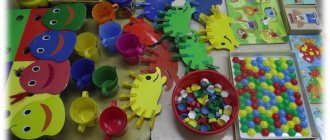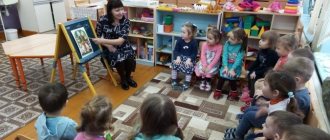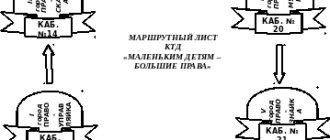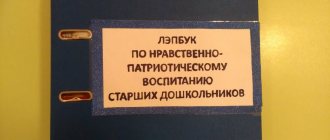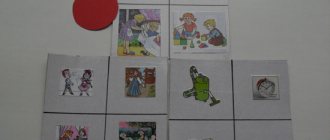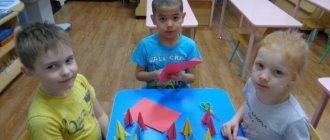Card index of games for patriotic education card index (preparatory group)
Card index of games for patriotic education
"Guests of the City"
Goal: to develop in children an interest in the life of their hometown and the country as a whole.
Equipment: photographs of city sights, a cube with numbers.
Progress of the game: pin six photographs with iconic places of the city on the board, pre-numbered with numbers from 1 to 6. The child rolls a dice with numbers to randomly select one of the pictures. The selected picture must be described in such a way that a visitor to the city understands the image and has a desire to visit this place. Cards with city views should be selected as recognizable as possible so that kids don’t have problems with the descriptions
"Heraldry"
Goal: studying the history of the native city through its symbolism.
Equipment: coats of arms and flags of your home city, region and country.
Progress of the game: first, the teacher shows the coat of arms of his hometown and briefly talks about what is depicted on it. The story needs to be told in simple and understandable language; usually the image of the city’s coat of arms carries a graphic image of its specifics and historical features. After that, he shows the coat of arms of the region and also talks about it. At the very end he moves on to the coat of arms of Russia. It is also necessary to talk about the flag of the city, region and country. Children should see the relationship between the flags of the city, region and country. Then the pictures are mixed. Children must put together the coat of arms and flag of the city, region, country. That is, split them into pairs. This game not only develops memory, it will help you learn about the symbolism of your native land.
"Our country"
Goal: to identify children’s knowledge about the Motherland, its capital.
Equipment: illustrations, photographs.
Progress of the game: the teacher shows illustrations and photographs, asks questions. The children answer.
"My address"
Goal: to develop the ability and knowledge of children to name their home address Equipment: ball
Progress of the game: everyone stands in a circle, the teacher passes the ball to the child and says his address. The child continues, calling his own, and passes the ball to his neighbor, etc.
“A journey along the route of good feelings, actions, deeds and relationships”
Goal: to draw children's attention to the fact that good feelings, actions and deeds evoke a feeling of respect, friendship and love. Form friendly relationships, establish rules of etiquette, rules of behavior. Equipment: pictures with different scenes of good deeds, good and bad behavior.
Progress of the game: the teacher begins a story about how one should behave in a particular place, what actions are good and what are bad. Then he shows the picture to the children and asks them to describe what is depicted in it.
"Tell me about your family"
Goal: to form an image of yourself as a family member. Show
the importance of family in a person’s life. Develop a desire to talk about your family members, be proud of them, love them.
Equipment: photo album compiled together with parents with family photographs with a family tree.
Progress of the game: children take turns talking about their families.
“How I help at home”
Goal: to form ideas about women’s household responsibilities and
men, girls and boys. Cultivate a desire to help people.
Equipment: pictures of people doing different jobs around the house.
Progress of the game: the teacher shows the card, suggests making a story based on it and telling who performs what duties at home.
"Noble Deeds"
Goal: to cultivate in children the desire to do things for the sake of other people.
To form an understanding that we call an action not only heroism, but also any good deed.
Equipment: ball, pictures and illustrations depicting noble deeds.
Progress of the game: children are asked to list noble deeds towards girls (women) and boys (men). The teacher throws the ball into the hands of one of the players, he names a noble deed and throws the ball to the next player at his request.
"Polite words"
Goal: to cultivate in children a culture of behavior, politeness, respect for each other, and a desire to help each other.
Equipment: plot pictures depicting different situations: a child pushed another, a child picked up a fallen thing, a child feels sorry for another child, etc.
Progress of the game: the teacher shows the card and offers to compose a story based on the picture.
"Help mom find her baby"
Goal: to teach children to correlate images of adult animals with their babies.
Equipment: pictures of animals and their cubs.
Progress of the game: pictures with adult animals and their cubs are mixed together, the task of the children is to collect all the images in pairs. The winner is the one who can collect all the animals in pairs as quickly as possible and without errors and name the animals correctly. After the game, the teacher talks about the importance for each cub to grow up in their own family.
"Flag of Russia"
Goal: to help consolidate knowledge of the flag of your country (city, region, regional center) to consolidate the main colors of the flags, what do they mean?
Material: red, blue and white stripes
Progress of the game: the teacher shows the children the Russian flag, removes it and offers to lay out multi-colored stripes in the order in which they are on the Russian flag.
"Name who"
Goal: to introduce children to the main people of the Russian Federation (Putin, Shoigu, Medvedev). Material: portraits of famous compatriots.
Progress of the game: the teacher shows the portraits, invites the children to name who is depicted in the portrait and tell what he is famous for.
"My parents' names are..."
Goal: to consolidate knowledge of the first and patronymic names of parents, grandparents... Material: family photo albums, ball.
Progress of the game: children, passing the ball to each other, quickly name the last name, first name, patronymic of mom and dad and other family members.
"Compliments"
Goal: to train children to compliment each other; develop speech and thinking; cultivate friendliness.
Progress of the game: children form a circle and hold hands. First, the teacher begins to speak to the child, whom he holds by the hand on the right. For example: “Misha, you are so polite today!” Next, the child turns to the child whom he is holding by the hand on the right. If a child finds it difficult to give a compliment, then other children help him.
- "Human Dwelling"
Goal: to consolidate children’s knowledge about human housing and what it is made of. Instill love for home, Motherland.
Material: pictures and illustrations depicting a person’s home Progress of the game: the teacher begins a story about where a person lives, that there are different types of housing: a hut, a hut...
Proverbs about family
- Where there is love and advice, there is no grief.
- Someone else's wife seems like a girl to everyone.
- My wife, don’t play the harp; after playing, you can’t hang it on the wall.
- A family is strong when there is only one roof over it.
- A husband without a wife is like a goose without water.
- Beauty to the crown, and intelligence to the end.
- A blind puppy crawls towards its mother.
- Every bride is born for her groom.
- The glory of a son is a joy to a father.
- He who honors his parents never perishes.
- A mother's prayer lifts you out from the bottom of the sea.
- Without a father, half an orphan, and without a mother, the whole orphan.
- There is no such friend as your dear mother and dear father.
- Parental blessing does not drown in water, does not burn in fire.
- Brotherly love is stronger than stone walls.
- The whole family is together, and the soul is in place.
- Bend the tree while it bends, teach the child while it obeys.
"Our kindergarten"
Goal: to consolidate children’s knowledge about kindergarten and kindergarten workers. What duties do they perform? Where is the band, music room, etc. located? Material: photographs and illustrations of the kindergarten, kindergarten workers. Progress of the game: from photographs and illustrations, children learn and talk about the kindergarten workers.
"Professions"
Goal: to teach children to recognize a profession by description; improve knowledge about the profession of adults; develop intelligence and attention.
Material: pictures with professions of adults.
Progress of the game: the teacher describes the adult’s profession; if the children guessed right, then he puts up a picture with this profession.
“All professions are important”
Goal: to consolidate children’s knowledge about adult professions; bring to the understanding that all professions are necessary and important; develop memory, attention, thinking. Material: pictures with professions of adults.
Progress of the game: the teacher offers to look at pictures of adults’ professions, name the profession and talk about its importance and usefulness.
At the end of the game, the teacher summarizes that all professions are necessary and important.
"Birds"
Goal: continue to introduce children to birds. Instill love for the homeland, native land, the animal world, a desire to help and care.
Material: cards with images of birds, album “Birds of our city, region”, compiled together with parents.
Progress of the game: The teacher shows the children cards with images of birds, asks them to name and determine whether the bird lives in our city or not.
"Who needs what for work"
Goal: to improve children’s knowledge about adult professions; find items needed for a specific profession; develop memory, intelligence, thinking.
Material: large pictures with the professions of adults (doctor, cook, driver) small cards with items necessary for these professions.
Progress of the game: on the chairs there are large pictures with the professions of adults, and cards with items necessary for these professions are scattered on the mat. Children are invited to take one card on the floor and go to the picture with the profession for which this thing is needed. Children explain why they approached this or that picture with a profession.
"Folk Crafts"
Goal: to introduce children to folk crafts, to instill an interest in Russian traditions, to teach them to recognize and distinguish different crafts.
Material: pictures and images with folk art objects Progress of the game: the teacher shows a picture with folk art objects and talks about them. After a short pause, the children are divided into teams, each of which must talk about one of the crafts they heard.
“Which tree is the leaf from?”
Goal: to consolidate children’s knowledge about the nature of their native land, to consolidate the ability to form relative adjectives (birch - birch, oak - oak, etc.)
Material: pictures and illustrations depicting trees and shrubs and leaves
Progress of the game: the teacher shows pictures depicting a leaf, then a tree.
"Green Pharmacy"
Goal: to consolidate children’s knowledge about medicinal plants of their native land; about their correct use for medicinal purposes.
Material: card index of medicinal herbs.
Progress of the game: the teacher shows a picture of a medicinal herb, the children guess. Talks about its healing properties.
"Little Red Book"
Goal: to consolidate children’s knowledge about rare plants and animals, birds of our region listed in the Red Book. Instill love for the homeland, native land, and a sense of responsibility.
Material: “Small Red Book”
Progress of the game: the teacher shows a picture depicting rare animals and plants, the children name them. The teacher talks about them.
“What holidays do you know?”
Goal: to develop children's intelligence and memory, to consolidate knowledge about holidays, (folk, state, religious) to consolidate the rules of behavior in public places.
Material: pictures and illustrations depicting holidays, postcards for various holidays.
Progress of the game: the teacher begins the story that there are different holidays, shows cards and postcards. Offers to choose a card with a holiday, and a themed card for it.
“Who lives in what country?”
Goal: to expand children's knowledge about the world and the people who inhabit it.
Material: paintings and illustrations with different countries of the world and people.
Progress of the game: the teacher shows the images and asks to determine what country this person is from and what they call him: China - Chinese, America - American.
"Countries and Peoples"
Goal: to expand children’s understanding of the countries of the Earth and their peoples. To instill an interest in the lives of people with different lifestyles, cultures and traditions. Instill respect for the culture and traditions of different peoples of the world.
Material: globe, world map, pictures and illustrations depicting different countries and peoples of the world.
Progress of the game: the teacher shows a picture depicting different
countries and peoples of the world. Talks about them.
"Continue the proverb"
Goal: to introduce oral folk word-making, to develop speech, memory, and logical thinking.
Progress of the game: the teacher begins the proverb, the children continue it. The teacher and the children find out the meaning of the proverb. If the children do not know the proverb, the teacher talks about it.
"Defenders of the Fatherland"
Goal: to form an idea of the army, to expand children’s knowledge about serving in the army.
Material: pictures and photographs depicting the military.
Progress of the game: the teacher gives homework to several children to prepare a story about a military man (tanker, sailor, pilot, etc.). The children tell, the teacher complements.
"Silhouettes"
Goal: to develop creative imagination and memory.
Material: famous landmarks of your home city and country, which are shown not in their color version, but in the form of a darkened image - a silhouette.
Progress of the game: the teacher shows silhouettes by which the children guess what is shown on this card.
